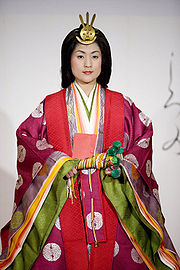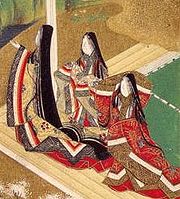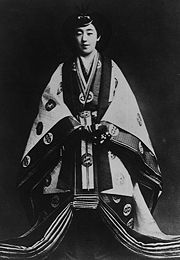
Junihitoe
Encyclopedia



Kimono
The is a Japanese traditional garment worn by men, women and children. The word "kimono", which literally means a "thing to wear" , has come to denote these full-length robes...
that was only worn by court-ladies in Japan
Japan
Japan is an island nation in East Asia. Located in the Pacific Ocean, it lies to the east of the Sea of Japan, China, North Korea, South Korea and Russia, stretching from the Sea of Okhotsk in the north to the East China Sea and Taiwan in the south...
. Literally translated, it means "twelve-layer robe". The older term, still used by scholars but not widely recognised in mainstream Japan, is Karaginu Mo. This is in reference to its Chinese
China
Chinese civilization may refer to:* China for more general discussion of the country.* Chinese culture* Greater China, the transnational community of ethnic Chinese.* History of China* Sinosphere, the area historically affected by Chinese culture...
coat (Karaginu) and apron-like train (Mo), the defining parts of the costume.
The jūnihitoe started to appear around the 10th century during the Heian
Heian period
The is the last division of classical Japanese history, running from 794 to 1185. The period is named after the capital city of Heian-kyō, or modern Kyōto. It is the period in Japanese history when Buddhism, Taoism and other Chinese influences were at their height...
Era. The various layers are silk
Silk
Silk is a natural protein fiber, some forms of which can be woven into textiles. The best-known type of silk is obtained from the cocoons of the larvae of the mulberry silkworm Bombyx mori reared in captivity...
garments. The innermost garment is made of white silk, followed by other layers which have various names, which are finally closed off by a final layer or coat
Coat (clothing)
A coat is a long garment worn by both men and women, for warmth or fashion. Coats typically have long sleeves and are open down the front, closing by means of buttons, zippers, hook-and-loop fasteners, toggles, a belt, or a combination of some of these...
. The total weight could add up to 20 kilograms.
The colours and the arrangements of the layers are very important. The colours have poetic names, such as "crimson plum of the spring". The only place where the layers are discernible is around the sleeve
Sleeve
Sleeve is that part of a garment which covers the arm, or through which the arm passes or slips. The pattern of the sleeve is one of the characteristics of fashion in dress, varying in every country and period...
s and the neck. The arrangements of the layers and their colours were a good indication to any outsider what taste and what rank the lady had. Apart from their robes, Japanese court ladies also wore their hair very long, only cut at the sides of their faces in a layered fashion; the longer hair was sometimes worn tied back.
An important accessory
Fashion accessory
Fashion accessories are decorative items that supplement and complement clothes, such as jewelery, gloves, handbags, hats, belts, scarves, wigs, watches, sunglasses, pins, stockings, bow ties, hand fans, leg warmers, leggings, neckties, suspenders, and tights....
was an elaborate fan
Fan (implement)
A hand-held fan is an implement used to induce an airflow for the purpose of cooling or refreshing oneself. Any broad, flat surface waved back-and-forth will create a small airflow and therefore can be considered a rudimentary fan...
, which could be tied together by a rope when folded. This was used by the lady not only to cool herself, since it could get very hot, but it was also an important communication device. Since a lady was not allowed to speak face-to-face to a male outsider, she could hold her sleeve up or use her opened fan to shield herself from inquiring looks. Communication to a suitor had to follow with her normally hiding behind the sudare
Sudare
are screens or blinds. They are sometimes called as well, particularly if they have a green fabric hem. Sudare are made of horizontal slats of decorative wood, bamboo, or other natural material woven together with simple string, colored yarn, or other decorative material to make nearly solid...
(screen or blinds) in any case. The suitor could only see the sleeves of her jūnihitoe that were peeking underneath the blinds. This practice was prominent during the Heian-Era, being frequently and accurately described in the Tale of Genji (jp: Genji monogatari).
The movement in such a robe could be difficult due to its weight. Ladies actually slept in their jūnihitoe sometimes, using it as a form of pajamas
Pajamas
Pajamas, also spelled pyjamas , can refer to several related types of clothing. The original paijama are loose, lightweight trousers fitted with drawstring waistbands and worn in South and West Asia by both sexes...
. Layers could be shed or kept, depending on the season and the night temperatures. During the Muromachi-Era, however, the dress was sometimes reduced to five robes (known as a "five-layer robe").
Contemporary use
Today the jūnihitoe can only be seen in museums, in movies, or at certain festivals. Production of jūnihitoe has almost died out. These robes are priceless and are one of the most expensive items of Japanese clothing. Only the Imperial Household still uses them at some important functions. During the wedding of Masako, Crown Princess of JapanMasako, Crown Princess of Japan
is the wife of Crown Prince Naruhito, the first son of the Emperor Akihito and the Empress Michiko, and a member of the Imperial House of Japan through marriage.-Early life and education:...
to the crown prince, she wore a jūnihitoe for the official ceremony. The jūnihitoe was also worn by Empress Michiko during the enthronement
Enthronement
An enthronement is a ceremony of inauguration, involving a person—usually a monarch or religious leader—being formally seated for the first time upon their throne. This ritual is generally distinguished from a coronation because there is no crown or other regalia that is physically...
ceremony of Emperor Akihito in 1990. Her ladies-in-waiting were all wearing the jūnihitoe, however in modified form from the Edo period
Edo period
The , or , is a division of Japanese history which was ruled by the shoguns of the Tokugawa family, running from 1603 to 1868. The political entity of this period was the Tokugawa shogunate....
, not the Heian style.
The Saiō Matsuri
Saio Matsuri
The Saiō Matsuri is a 2 day festival held on the first weekend of June in the town of Meiwa, Mie Prefecture in Japan. The Saiō Matsuri celebrates the town's history of once being an Imperial residence. The festival re-enacts the march of the Saiō and her entourage to the nearby Ise Shrine...
Saiō Festival is held every in Meiwa, Mie
Meiwa, Mie
is a town located in the Taki District, of central Mie Prefecture, on the island of Honshū, Japan.In 1958, the town of Sanwa and the village of Saimei merged to form the town of Meiwa.-History:...
and showcases Heian era dresses. They are also featured at the Aoi Matsuri
Aoi Matsuri
The , or "Hollyhock Festival," is one of the three main annual festivals held in Kyoto, Japan, the other two being the Festival of the Ages and the Gion Festival. It is a festival of the two Kamo shrines in the north of the city, Shimogamo Shrine and Kamigamo Shrine...
in Kyoto
Kyoto
is a city in the central part of the island of Honshū, Japan. It has a population close to 1.5 million. Formerly the imperial capital of Japan, it is now the capital of Kyoto Prefecture, as well as a major part of the Osaka-Kobe-Kyoto metropolitan area.-History:...
.
The Layers of the jūnihitoe
The layers of the Jūnihitoe consist of:- The undergarments: Usually a two-piece cotton or silk garment.
- KosodeKosodeThe kosode is a basic Japanese robe for both men and women. Worn as both an undergarment and overgarment, it is what most people imagine when using the much broader term kimono. The literal meaning of the term kosode is "small sleeve," which refers to the sleeve opening.Kosode are T-shaped, have a...
: A short silk red or white robe of ankle or lower calf length. - Nagabakama: A very long red pleated split skirt which can also be worn by men.
- Hitoe: An unlined silk robe; usually red, white or blue-green, although other colors (such as dark red-violet or dark green) very rarely occur.
- Uchigi: A series of brightly coloured unlined robes which create a layered effect.
- Uchiginu: A beaten scarlet silk robe worn as a stiffener and support for the outer robes.
- UwagiUwagiAn Uwagi is a kimono-like jacket worn in Japan. It is most familiar as the top half of a martial arts uniform.The third element, the obi belt, ties closed the uwagi and holds up the zubon....
: A patterned woven and decorated silk robe than is shorter and narrower than the Uchiginu. - Kouchigi: (lit., "small cloak") a shorter brocade robe worn over the uchigi or uwagi to add some formality on occasions when the karaginu and mo were NOT worn; (img)
- Karaginu: A waist length Chinese style jacket.
- "Mo": An apron-like train, down the back of the robe. White with painted/embroidered adornment.
External links
- The Costume Museum | The Heian Period
- Image of a jūnihitoe
- Encyclopaedia Britannica: Juni Hitoe
- Gallery of Junihitoe Images
- Reference Chart of Juunihitoe Color Schemes (note: incomplete with some translation errors, but includes uwagi and karaginu colors)
- Reference Chart of Juunihitoe Color Schemes (note: complete, but written in Japanese characters and without uwagi/karaginu color information)
- Historical Reenactor's Project to Recreate a Juunihitoe- variant 1 (with notes)
- Historical Reenactor's Project to Recreate a Juunihitoe- variant 2 (with notes)
- How a Juunihitoe is Donned (thumbnail list links)

